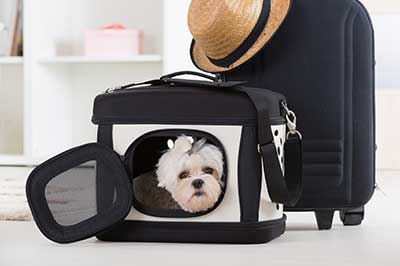Tips for Traveling with a Pet
Last updated February 2024
Before taking your pet with you on a trip, consider the following advice, drawn from several publications, including AAA’s Traveling with Your Pet website.
For Any Travel
- Take note of your pet’s capabilities, and prepare it for the trip. Don’t plan a camping trip with arduous hikes if your dog never takes long walks.
 Before the trip, take your pet to the vet for a checkup, and make sure all vaccinations are current. Most states require proof of rabies vaccinations.
Before the trip, take your pet to the vet for a checkup, and make sure all vaccinations are current. Most states require proof of rabies vaccinations.- Obtain a health certificate from your vet no earlier than 10 days before departure.
- Make sure your pet has a collar ID with its name, your name, home address, and phone number.
- If you will be using a crate, make sure it is large enough for your pet to stand, sit, and change positions.
- Bring familiar toys or bedding to make your pet more comfortable in an unfamiliar environment. Maintain your dog’s regular feeding and exercise schedules, and stop often to let your dog stretch and urinate.
- Sedatives and tranquilizers may be harmful to your pet. Drug it only if your veterinarian recommends it.
- Don’t forget food and water bowls, a brush or a comb, towels to wipe muddy paws, and plastic bags.
For Air Travel
- Pets can experience breathing difficulties at high altitudes.
- They may suffer from exposure to temperature extremes. Tarmac and cargo holds where pets wait—first to be loaded onto the plane and then for the plane to taxi to the runway, take off, or unload—are subject to extreme temperatures. Heat emanating from a cement surface, coupled with the heat from plane engines, can quickly cause heat exhaustion and dehydration. Even after the sun goes down, cargo holds can retain and emit heat. Delays can be a problem: The temperature in the cargo hold can become too hot (or too cold, depending on the season) when a plane waits at the gate or on the runway for extended periods.
- Airlines make mistakes. Pets have been forgotten and left on the tarmac in extreme temperatures or sent to the wrong destination, requiring long and harrowing trips to correct the error.
- Pets can suffer from nervous disorders and trauma. Noise in the cargo hold or turbulence can be frightening. Plus, some animals get air sickness.
- Not all destinations will welcome your pet. Quarantine laws in Hawaii and many foreign destinations require animals to be sequestered before joining you. Some forbid the entry of pets altogether.
If your pet must fly, follow these steps to ensure your pet’s safety:
- Call the airline or visit its website to determine the policies, procedures, and restrictions for flying with a pet.
- Try to book a nonstop flight.
- Check to see if your pet can fly with you in the passenger cabin as carry-on luggage. Most airlines now allow this—by reservation—for a limited number of animals per plane in carriers small enough to fit underneath seats.
- Check whether the airline requires a vet’s health certificate for your pet—most now require them for pets checked as baggage but not for pets carried on.
- If you must fly during the warm season (or to warm climates), try to fly early in the morning or late at night; if you fly during winter, try to fly during the day.
- Make sure the crate for your pet is approved for shipping animals. The crate should be large enough so your pet can stand up, turn around, and lie down. Be sure its latches work. Also, make sure the crate is securely closed, but don’t lock the crate.
- Line the crate with absorbent material.
- Write “LIVE ANIMAL” in large letters on the top of the crate and on at least one side.
- Make sure airline tags show the correct destination.
- If you’re checking the pet as baggage, secure an empty food and water dish to the inside of the crate. For trips longer than 12 hours, attach a plastic bag containing dry food and feeding instructions. These items (which should be attached to the crate) must be accessible to airline personnel.
For Car Travel
- Never leave a pet alone in a car.
- For safety, it is important that a dog responds to such voice commands as “Sit,” “Stay,” and “Down.”
- A crate-trained pet is more likely to feel safe in an unfamiliar environment, and hotel staff may be more inclined to admit your pet if you tell them it is crated.
- Before you make reservations for accommodations, make sure pets are allowed. If so, ask about the facility’s rules and fees.


